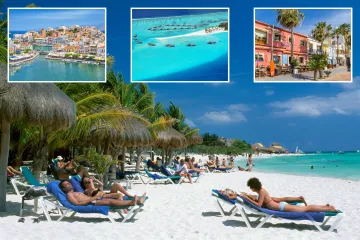The top-rated hotel named the best for families with colouring stations for kids and baby concierge
EVERY family hopes for a stress-free holiday and this hotel gives you the best chance of that.
From kids clubs to complimentary baby equipment, a hotel in the Algarve has incredible children’s facilities not to mention beautiful nearby beaches.
The Telegraph named the Martinhal Sagres as being the hotel that’s ‘Best for Families’ in its world’s 50 greatest hotels.
The publication said that one reason is thanks to the staff who “set up colouring stations to allow parents to finish their food peacefully to playing football with junior guests on the beach.”
The hotel states on its website that “everything about Martinhal Sagres is designed with families in mind. Stylish and design-oriented.
“Martinhal Sagres offers families a luxury beach holiday experience with high-class family-friendly accommodation, restaurants and bars, kids’ and leisure services to suit the needs of each family member.”
The hotel even offers family and baby concierges which give personal assistance for families and their little ones.
With them you can get expert advice on childcare and family-friendly activities.
You can also pre-book complimentary baby equipment – from small items like door protectors, potties, bottle sterilizers and warmers, to cots, baby baths and pushchairs.
The hotel has its own crèche for children between six and 23 months which has activities like hand and foot painting.
Raposinhos is a club for two to five-year-olds with story time, puppet shows as well as arts and crafts – and time outside in the playground and on tricycles.
The Fox Club is for six to eight-year-olds where they can play football and play games outside, as well as explore the small on-site forest.
Other leisure activities that children can join in with include horse riding, tennis or head to the watersport academy for fun on inflatables.
Other facilities include a spa, gym, heated indoor pool, games room with play corners, pool table, Xbox and PlayStation.
Outside of the hotel are plenty of the Algarve’s beaches, the nearest being Praia do Martinhal.
When it comes to food, there’s a family-friendly restaurant called Quinta do Lago which has a special children’s menu and fresh purees for babies.
Accommodation varies from a stay in one of the main hotel rooms, as well as houses with two or three bedrooms all the way up to its luxury villas.
It even has a ‘Baby’s First Holiday package’ which is four nights in a Beach Room or 1-bedroom apartment with breakfast included.
It includes a baby welcome pack upon arrival, a first water experience, one session in the crèche each day, a spa treatment for parents and a dinner where a hotel babysitter will take care of the little one.
This offer is €129 (£112.64) per adult per night for two adults and one baby (from 6 months up to 23 months).
This English hotel was named the best for families with ‘milk butlers’, film screenings and cookies at bedtime…

This plush hotel in the New Forest is every parent’s dream.
With lots of children’s activities and even complimentary daycare, it’s the ideal hotel for both kids and parents.
New Park Manor in Brockenhurst has everything for families to have fun, but also experience a relaxing break altogether.
It was even awarded the title of “best family-friendly hotel” by The Times in its 100 Best Places to Stay in the UK for 2025.
The hotel offers many ways for a family-friendly break including a “milk butler service”.
Front of house staff will prepare little ones a bottle of warm milk whether it’s day or night, and they get a choice of cow’s, soya, and oat milk.
What was described as a “game changer” is the complimentary time at the kids’ club.
The hotel offers all guests a free two hour session per night’s stay.
The Four Bears Den is an Ofsted-registered kids’ club within the hotel and has entertainment for children aged 3 months to 8 years.
Some adults even said they took the time away from their children to “sneak off to the spa” in their Tripadvisor review.
For adults, there’s a heated pool, steam room, spa and adults-only sun terrace with two outdoor hot tubs.
For more on the Algarve, check out what Assistant Travel Editor, Sophie Swietochowski, made of her trip – from where to eat to finding hidden coves.
Plus, discover the countryside spa hotel with outdoor hot tubs overlooking Highland cows.


